When I was really little, my dad worked for Texas Instruments and Mostek, making chips for Atari cartridges.
Video game cartridges: a brief history (part 1)
|
|
On 11/23/2021 at 01:06 AM by SanAndreas See More From This User » |
Over the years, there have been many different types of cartridge software released. Where music and video media (eventually) became standardized, each game system had its own form of storage media. In addition to carrying interchangeable game software, companies tended to make the design and appearance of the cartridges themselves distinctive as a marketing gimmick. Most of us have memories of having game cartridges in boxes, not to mention blowing on the edge connectors when our games glitched out. So here's a brief overview of various game cartridges throughout history. This is not an exhaustive list.
Magnavox Odyssey (1972)
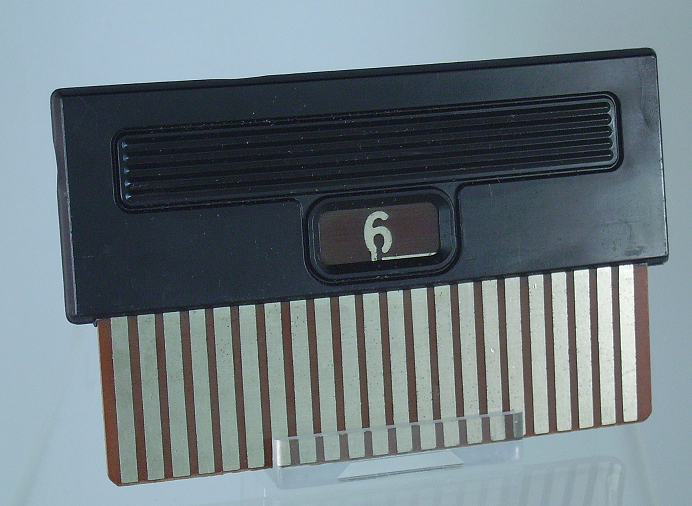 Designed by Ralph Baer, the Odyssey was one of the earliest commercial home video games. It played simple Pong-styled games with plastic overlays that fit over your TV screen. Its cartridges were simple jumpers that altered the system's circuitry to change the placement and movement of the dots on the screen
Designed by Ralph Baer, the Odyssey was one of the earliest commercial home video games. It played simple Pong-styled games with plastic overlays that fit over your TV screen. Its cartridges were simple jumpers that altered the system's circuitry to change the placement and movement of the dots on the screen
Fairchild Channel F (1976)
 The first console to feature truly interchangeable cartridge-based software, as well as the first system with a microprocessor, both of which allowed for games more complex than simple Pong variations. Jerry Lawson, a Fairchild engineer, invented and designed cartridges that were ROMS encased in a protective plastic casing. They plugged horizontally into the system on its right hand side. The cartridges resembled yellow 8-track tapes, which was likely a deliberate design choice. Consumers in the 1970s were leery of computers and video games, so many companies tried to make them more approachable by making the consoles and games look like more familiar A/V components. Part of the reason why cartridges were so bulky was to ensure adequate ventilation of the solid-state components. The Channel F only sold 350,000 units, so its contributions to video gaming history, and Lawson's, are often overlooked.
The first console to feature truly interchangeable cartridge-based software, as well as the first system with a microprocessor, both of which allowed for games more complex than simple Pong variations. Jerry Lawson, a Fairchild engineer, invented and designed cartridges that were ROMS encased in a protective plastic casing. They plugged horizontally into the system on its right hand side. The cartridges resembled yellow 8-track tapes, which was likely a deliberate design choice. Consumers in the 1970s were leery of computers and video games, so many companies tried to make them more approachable by making the consoles and games look like more familiar A/V components. Part of the reason why cartridges were so bulky was to ensure adequate ventilation of the solid-state components. The Channel F only sold 350,000 units, so its contributions to video gaming history, and Lawson's, are often overlooked.
Atari 2600 (1977)
The 2600 was the first successful cartridge system, and set the standard for cartridge systems until just after the turn of the century. Its cartridges were smaller than the Channel F cartridges, and plugged vertically into the top of the system, making them easily storable.
Third parties such as Activision, Parker Bros, Coleco, and Imagic produced their own cartridges, as there was no real lockout or licensing system and Atari tended to see third parties as competitors getting rich off of its work. Activision kept with the same basic shape of the cartridges, but the labels were one continuous piece of paper that covered the face and the end of the cartridge.
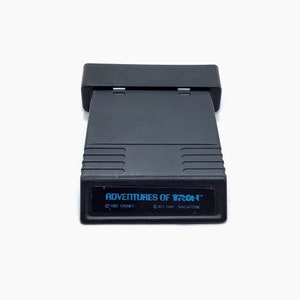 Do these unusual 2600 cartridges look like Intellivision cartridges? That's because they are. They were all put out by M Network, a division of Mattel that ported a number of Intellivision games to the much more successful 2600. Mattel attached adapters to the bottom of the Intellivision casings to permit them to fit the 2600's larger cartridge slot.
Do these unusual 2600 cartridges look like Intellivision cartridges? That's because they are. They were all put out by M Network, a division of Mattel that ported a number of Intellivision games to the much more successful 2600. Mattel attached adapters to the bottom of the Intellivision casings to permit them to fit the 2600's larger cartridge slot.
Odyssey2 (1978)
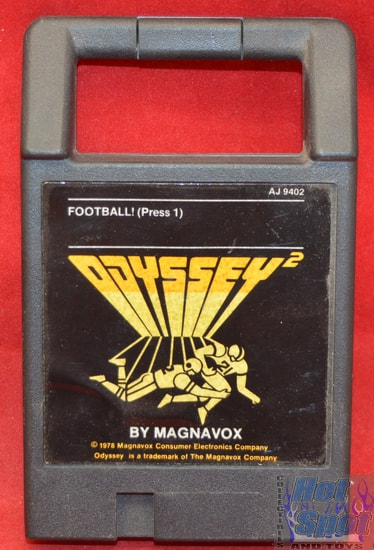 Philips's second console was a more advanced console/computer hybrid. Its cartridges, known as "VideoPacs", plugged into the top of the console. Notably, they had handles at the top to facilitate easy removal. Odyssey2 cartridges often had multiple different games on them, unlike Atari cartridges which only had one single game program. Magnavox also felt the need to punctuate every game title with an EXCLAMATION POINT!
Philips's second console was a more advanced console/computer hybrid. Its cartridges, known as "VideoPacs", plugged into the top of the console. Notably, they had handles at the top to facilitate easy removal. Odyssey2 cartridges often had multiple different games on them, unlike Atari cartridges which only had one single game program. Magnavox also felt the need to punctuate every game title with an EXCLAMATION POINT!
Bally Professional Arcade/Astrocade (1978)
 The Professional Arcade's cartridges were designed, in size and shape, to resemble Compact Cassettes. Though cassettes had been used in early computers as storage media, these were solid-state cartridges. They were among the easiest cartridges to deal with, slipping flat into the system like a cassette and easily popped out with an eject button. The console even had built-in storage for your game cartridges so you wouldn't lose them. This system deserved to do better than it did. The Professional Arcade also came with two built-in games: Checkmate, a snake game, and Gun Fight, a port of a two-player shoot-em-up originally developed by Taito in Japan, which was controversial for having realistic (for the time) death animations.
The Professional Arcade's cartridges were designed, in size and shape, to resemble Compact Cassettes. Though cassettes had been used in early computers as storage media, these were solid-state cartridges. They were among the easiest cartridges to deal with, slipping flat into the system like a cassette and easily popped out with an eject button. The console even had built-in storage for your game cartridges so you wouldn't lose them. This system deserved to do better than it did. The Professional Arcade also came with two built-in games: Checkmate, a snake game, and Gun Fight, a port of a two-player shoot-em-up originally developed by Taito in Japan, which was controversial for having realistic (for the time) death animations.
Intellivision (1978)
 Intellivision cartridges had angled end-labels and were somewhat smaller than 2600 cartridges. They plugged into the side of the console, having to be pushed into the slot for about half of their length.
Intellivision cartridges had angled end-labels and were somewhat smaller than 2600 cartridges. They plugged into the side of the console, having to be pushed into the slot for about half of their length.
Milton Bradley Microvision (1979)
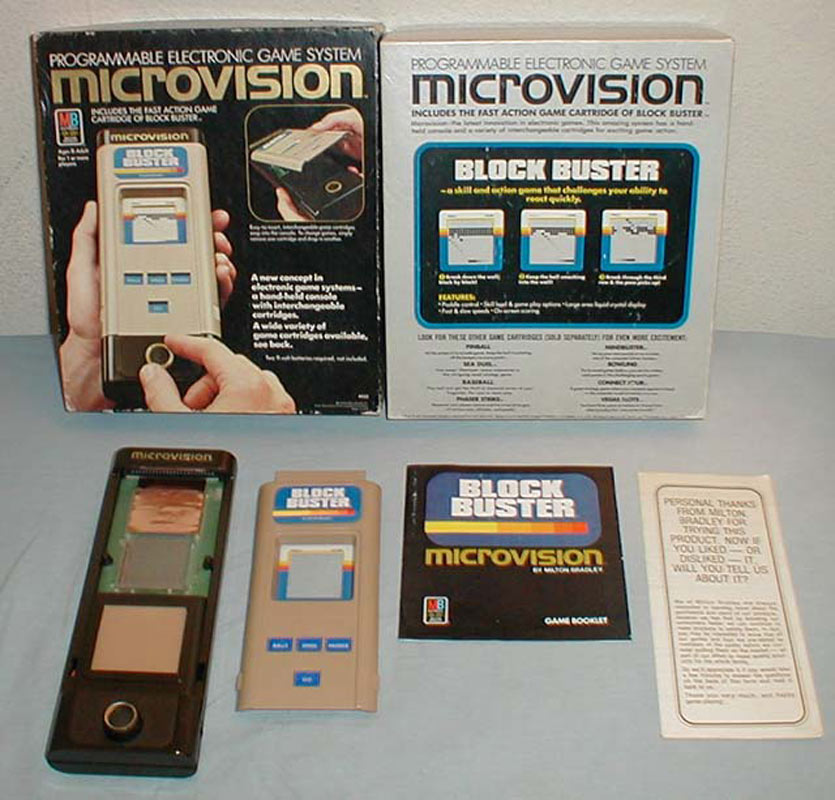 The first handheld gaming system with interchangeable cartridges. Notably, the actual system consisted only of the controls and the LCD display. The actual computing equipment, including the microprocessor, was carried entirely on the cartridges themselves. The cartridges were actually full-blown overlays that snapped over the top of the LCD screen and controller unit.
The first handheld gaming system with interchangeable cartridges. Notably, the actual system consisted only of the controls and the LCD display. The actual computing equipment, including the microprocessor, was carried entirely on the cartridges themselves. The cartridges were actually full-blown overlays that snapped over the top of the LCD screen and controller unit.
Atari 400/800/XL/XE (1979)

In the early days of computing, even personal computers used cartridges as a storage medium. Atari's 8-bit line, except for the low-end 400, featured "Left" and "Right" cartridge slots. In practice, almost all cartridge software was released for the Left cartridge slot. I never saw any "right cartridges" personally, and this picture is the first time I've ever seen a "right cartridge." The Atari 8-bit line helped illustrate how fast traditional cartridge ROMs were. On cartridge, Pac-Man would load up instantly as soon as the system was turned on. On floppy disk, Pac-Man took a couple of minutes to load, since the entire game had to be loaded into RAM. Early Atari computers had top-loading cartridge slots, similar to the 2600, but the 130XE I had had the cartridge slots in the back of the computer.
 Texas Instruments TI-99/4/4A (1979)
Texas Instruments TI-99/4/4A (1979)
TI's cartridges, called "Command Modules," plugged horizontally into a forward-facing cartridge slot on the right side of the computer, similar to the Fairchild Channel F. This kept the form factor from being distorted by having a cartridge sticking out. Notably, the TI not only released games, but also productivity and financial software, on cartridge. Cartridges varied somewhat according to the manufacturer. Atari released a number of ports of its popular arcade games (well, the ones it licensed from companies like Williams and Namco, anyway) for the TI on cartridges whose shape was meant to elicit the circuit boards in the 2600 cartridges. Milton-Bradley released an expansion module called the MBX Expansion that had its own cartridges.
Yep, those are cartridges for spreadsheets for your mom and dad to manage the family's finances. Imagine getting one of those for Christmas instead of Pac-Man.
Commodore 64 (1982)
The most popular computer in the era before VGA graphics made Wintel machines the PC standard, it used cartridges similar to the 2600's cartridges that plugged into the side of the computer, that were used to sell productivity, finance, and educational software in addition to games. The cartridges plugged into the side of the C64, similar to the Intellivision.
Atari 5200 (1982)

The 5200's cartridges kept the same basic shape as the 2600, but were somewhat larger to prevent them from being plugged into the 2600 by unwitting consumers, as the 5200 was not backwards-compatible with the 2600. Perhaps the big size of the cartridges was also meant to convey that 5200 games were bigger and better than 2600 games.

ColecoVision cartridges used the familiar shape of the 2600 cartridges. In addition, with an expansion module, the ColecoVision could natively play 2600 cartridges, for which Atari sued Coleco for patent infringement. The companies later settled out of court.
Nintendo Entertainment System/Family Computer (1985/1983)
 In 1983, just as the video game industry in the United States was collapsing under a mountain of E.T. and Pac-Man cartridges and an avalanche of shovelware and extremely pixelated pornography, Nintendo released the Family Computer in Japan. In 1985, the NES was born. Nintendo's strategies on either side of the Pacific were very different. The Famicom was very colorful and family-friendly, with small, compact cartridges that loaded vertically into the top of the system. Very sleek and easy to store. Not only that, but the labels and the cartridges themselves were very colorful.
In 1983, just as the video game industry in the United States was collapsing under a mountain of E.T. and Pac-Man cartridges and an avalanche of shovelware and extremely pixelated pornography, Nintendo released the Family Computer in Japan. In 1985, the NES was born. Nintendo's strategies on either side of the Pacific were very different. The Famicom was very colorful and family-friendly, with small, compact cartridges that loaded vertically into the top of the system. Very sleek and easy to store. Not only that, but the labels and the cartridges themselves were very colorful.
Meanwhile, in the US, Nintendo tried in every way possible to distance itself from the remains of the pre-1983 US video game industry. Retailers felt burned by huge stocks of unsold cartridges, while gamers and parents felt burned by the huge flood of shovelware that came out on the 2600. In order to bring people around, Nintendo tried to avoid any references to video games. The NES was given a gray, boxy design to make it look like an A/V component, following in the footsteps of companies like Fairchild and Bally. The cartridges were big and gray (except for the gold-colored Zelda games, of course). Nintendo even avoided using the term cartridge, calling its software media "Game Paks." They plugged into a slot behind a door on the boxy NES in a way suggestive of putting a VHS cassette into a VCR. At that time, the home video revolution was in full swing. Another feature which became standard on game cartridges going forward was a lockout system in an effort to prevent game releases that weren't authorized by Nintendo. For the NES, that meant that the cartridge slot contained a "lock" chip, while an official Nintendo cartridge would have a "key" chip. Both chips would have to "handshake" in order for the game to work. Inconsistencies in doing so, as well as contacts in the cartridges and NES being being during cartridge insertion, caused the infamous "blinking" and other glitches that we all tried to fix by blowing imaginary dust off of the cartridge contacts. Nintendo even utilized cartridge appearance to impress on game buyers that The Legend of Zelda was a very special game by making its cartridge casings metallic gold instead of gray. In order to assure parents that their money was hopefully being well spent on authentic Nintendo products that were fun to play and not likely to be pornographic, the Official Nintendo Seal of Quality was printed on the labels of every officially Nintendo-licensed game, which continues to this day.
One other major innovation NES cartridges featured was the use of RAM chips for saving. RAM is a volatile memory, that is, as soon as power is cut to the RAM chip, anything running on it is wiped clean. Save RAMs had their own power source, usually a CR2032 button battery that would last for years, that kept the RAM chips powered and thus kept them from losing the data stored on them. Before this, unless the system supported a floppy or cassette tape backup, saving was impossble, and continuing a game meant entering long "passwords." This made lengthy RPGs and adventure games like The Legend of Zelda possible on cartridges.
Of course, hacking is always an arms race between manufacturers and hackers that the manufacturers inevitably end up losing, so a number of well-known unauthorized cartridges found their way to the NES. After publishing Pac-Man, RBI Baseball, and Gauntlet through Nintendo's official channels, Atari, through its subsidiary Tengen, told a less-than-truthful story to the US Patent Office` to obtain the patents Nintendo filed for the NES lockout chip and produced its own line of unauthorized cartridges, because Atari did not want to pay royalties to Nintendo or abide by its rules on ordering and manufacturing NES cartridges that made software flops very expensive for publishers. Tengen released a number of ports of Atari, Namco, and even Sega games on the NES - all companies that were either competitors or had very poor relations with Nintendo. on black cartridges made of the same plastic used to manufacture Atari cartridges, that were shaped somewhat similarly to Atari cartridges. Nintendo promptly sued for copyright infringement, and won.
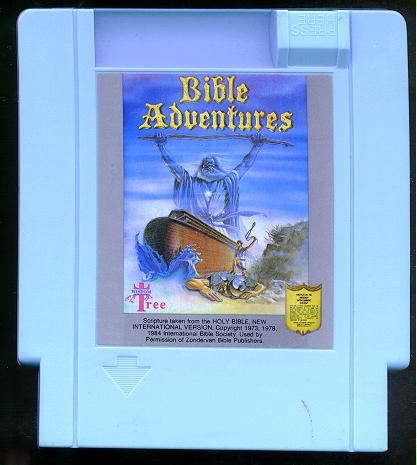 Color Dreams, a US-based company, released bootleg Nintendo games, most of them of rather poor quality, on baby blue cartridges. Nintendo had limited success in keeping Color Dreams locked out of the NES, so they simply told retailers that they would not sell games through retailers that carried unlicensed Nintendo games. At that time, that was a threat that could bring even the almighty Wal-Mart to its knees. So Color Dreams decided to start producing Christian-themed video games and selling them through Christian bookstores, reasoning that since they didn't carry the NES in the first place, there was no leverage Nintendo could apply to scare them into not carrying Wisdom Tree games.
Color Dreams, a US-based company, released bootleg Nintendo games, most of them of rather poor quality, on baby blue cartridges. Nintendo had limited success in keeping Color Dreams locked out of the NES, so they simply told retailers that they would not sell games through retailers that carried unlicensed Nintendo games. At that time, that was a threat that could bring even the almighty Wal-Mart to its knees. So Color Dreams decided to start producing Christian-themed video games and selling them through Christian bookstores, reasoning that since they didn't carry the NES in the first place, there was no leverage Nintendo could apply to scare them into not carrying Wisdom Tree games.
Sega Master System (1985)
The Master System actually employed two different storage media. For the most part, games came on the familiar rectangular top-loading cartridges. Budget releases, however, came on software media in a new form factor: the game card. Roughtly the size and shape of a credit card, these Sega Cards plugged into a thin slot on the front of the Power Base, leaving most of their surface area exposed to air. There weren't many games released on Sega Card, but the appeal of the format was big; these cards were smaller and cheaper to manufacture than big, bulky cartridges.
Atari 7800 (1986)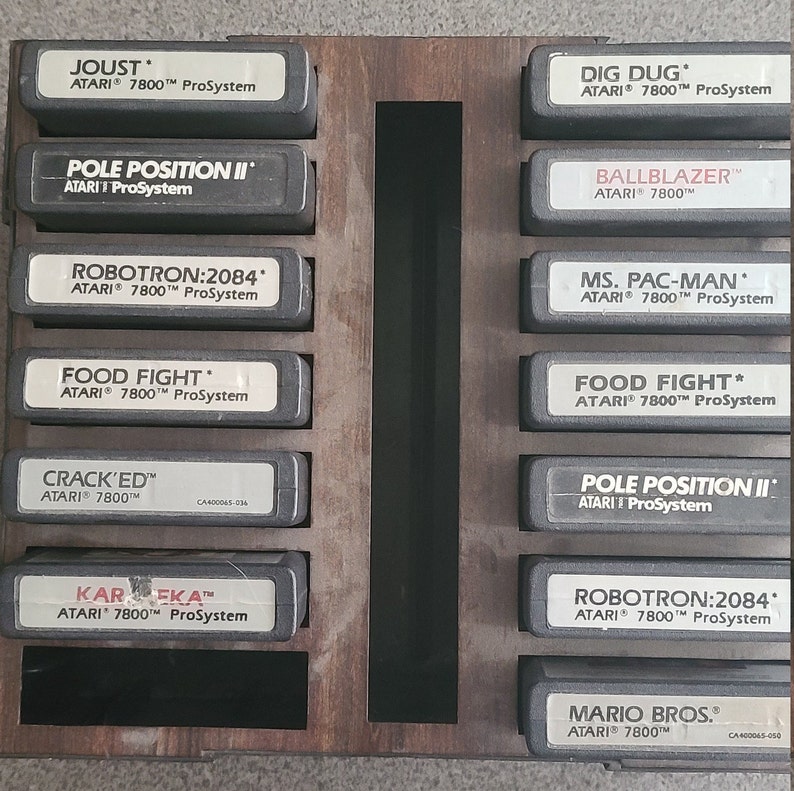
The 7800's cartridges were identical in size and shape to the 2600, and loaded into the top of the unit like a 2600. The 7800 was fully backwards compatible with the 2600, as Atari hoped to give 2600 fans a risk-way free to jump into next generation.
TurboGrafx-16/PC Engine (1987)
Hudson Soft's game console also ran off of credit-card sized game cartridges, this time known as HuCards. They were preceded by the earlier Bee Card, a storage medium Hudson developed for the Japanese MSX computer platform. I think Hudson had hoped that HuCards would become a standardized format for computer software beyond the TG-16.
The TG16 also holds another important distinction in game media: it was the first-ever game console to utilize optical discs through the CD-ROM2 add-on, in 1988. Despite the promise of being able to have a then unheard of 650 GB of video game storage, the price and slow speed of CD-ROM drives ensured that it would take at least seven more years for optical discs to become the standard in video game media. Even then, they never quite replaced cartridges, and it is quite possible, with Nintendo continuing to use solid-state media and its competitors relying increasingly on digital distribution, that cartridges may yet outlive optical discs.
So that's the history of video game cartridges for the first few years. From the 1990s onward, game cartridges would face competition as a storage medium from optical media, digital downloads, and streaming. Yet the format keeps going. The next blog will take a look at some of these later cartridges. How many of these cartridges do you have in your collection?



Comments